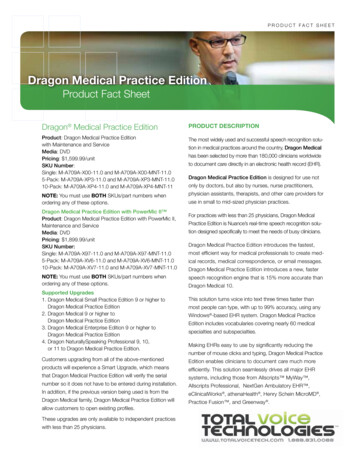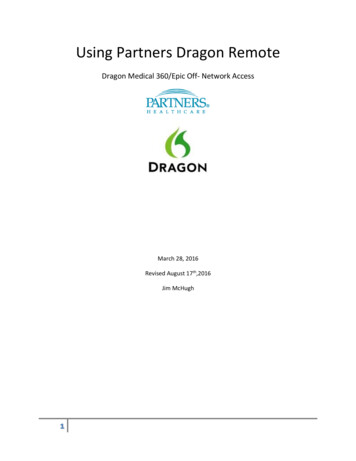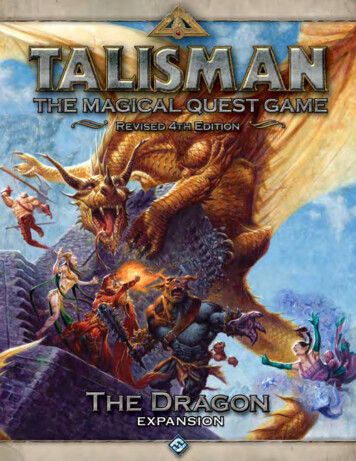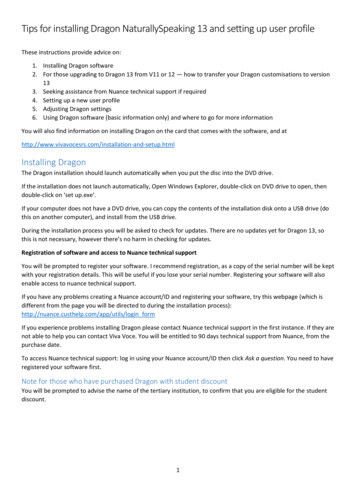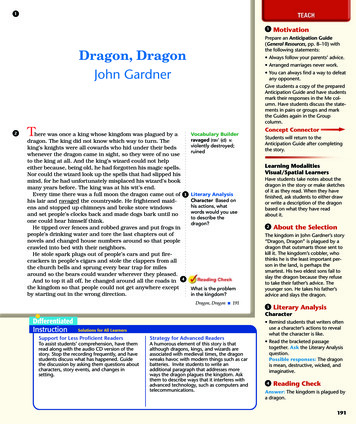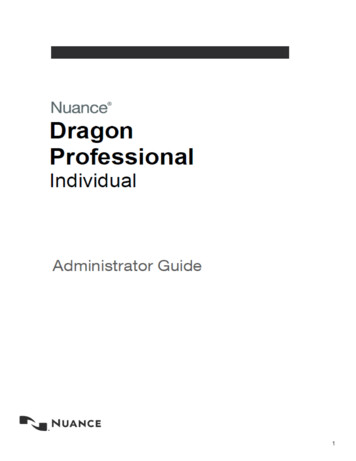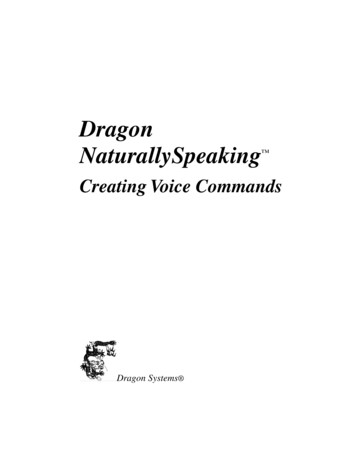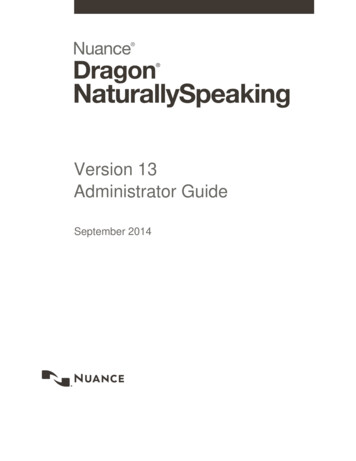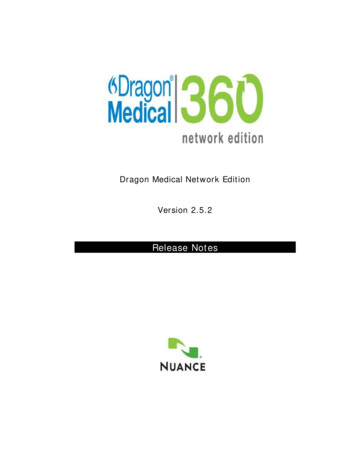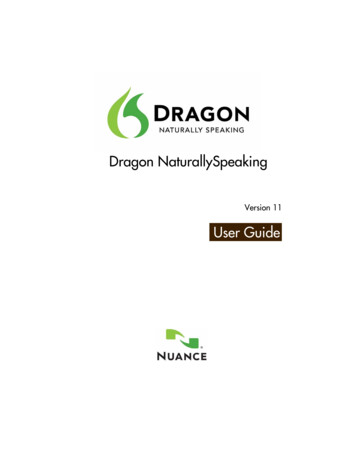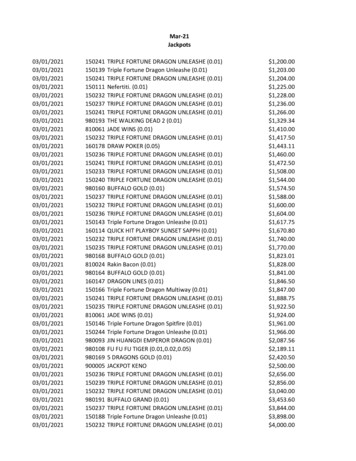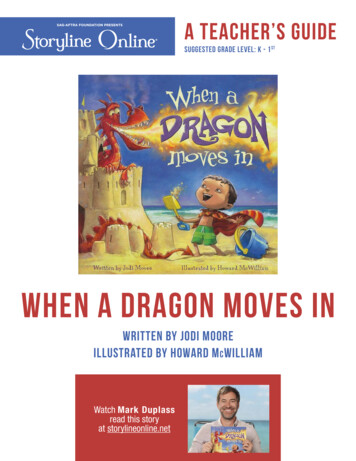
Transcription
a teacher’s guidesuggested grade level: k - 1 stwhen a dragon moves inwritten by jodi mooreillustrated by howard m c williamWatch Mark Duplassread this storyat storylineonline.net
about this storySYNOPSISIf you build a perfect sandcastle, a dragon will move in. And that’s exactly what happens to one very lucky boyat the beach. Dad is busy sunbathing and Mom is busy with her book, so the boy and dragon roam the beachtogether, flying a kite, braving the waves, and roasting marshmallows. But no one believes him when he sharesthe news of his magnificent dragon: Mom only hears the roar of the ocean, Dad thinks the dragon feather isa seagull feather, and know-it-all Sis claims there’s no such thing as a dragon. That’s when the sandwichesmysteriously disappear, claw prints are found in the brownies, and dragon-giggles erupt from the strangestof places. Heh-heh-heh. Is there truly a mischievous dragon running around on the beach or is someone’simagination running wild? Decide for yourself When a Dragon Moves In.THEMES IN THE STORYFriendship, Imagination and FamilyPAGE 2 A teacher’s GUIDE when a dragon moves in 2020 SAG-AFTRA FOUNDATIONAbout This Guide: The purpose of this guide is to enhance the ELA curriculum by providing quality children’s literature to engagestudents in listening to expressive read alouds. Suggested story related activities are aligned with ELA Common Core Standards.
reading and writingSuggested grade level: k - 1 stela common core standardReading Literature: Students read and respond to works of literature with emphasis on comprehension, makingconnections among ideas and between texts with focus on textural evidence. Standards listed below are forKindergarten and 1 st grade but can be adapted to 2 nd grade standards.before viewingStandards:CCSS.SL.K.1, CCSS.SL.K.1B, CCSS.SL.1.1, CCSS.SL.1.1BObjective:Tap knowledge and build background to prepare for reading the story.Procedure:Step 1: Build background by discussing the following topics with students: Building sandcastles at the beach Dragons Imagination and imaginary creaturesStep 2: Introduce the title, When a Dragon Moves In, and have students predict what might happen.during viewingFocus:Making Predictions, Reality/Fantasy, Using IllustrationsStandards:CCSS.SL.K.2, CCSS.RL.K.1, CCSS.RL.K.7, CCSS.SL.1.2, CCSS.RL.1.1, CCSS.RL.1.7Objective:Students will listen to the story for understanding.Procedure:Use the following prompts to engage students in the story as they listen: Tell students to make predictions as they listen – What will happen next? Reality vs fantasy: Have students give a thumbs up for somethingthat can really happen (reality) and a thumbs down for things that are not real(fantasy). Have students look at the illustrations and describe the relationshipbetween the illustration and the text.PAGE 3 A teacher’s GUIDE when a dragon moves in 2020 SAG-AFTRA FOUNDATIONAbout This Guide: The purpose of this guide is to enhance the ELA curriculum by providing quality children’s literature to engagestudents in listening to expressive read alouds. Suggested story related activities are aligned with ELA Common Core Standards.
after viewingStandards:CCSS.RL.K.1, CCSS.RL.K.2, CCSS.RL.K.3, CCSS.RL.1.1, CCSS.RL.1.2, CCSS.RL.1.3Objective:Students will ask and answer questions about key details in the story.Materials:Stickers (optional)Spinner: Who? What? Where? When? Why? How?Paper platePaper clipMarkerTeacher Prep:Construct a spinner: Divide the paper plate into sixths. Label each section with a question word.Unfold the paper clip and poke it through the center of the plate. Bend the end that’s sticking throughthe bottom of the spinner so it doesn’t fall out.Procedure:The activity can be adjusted to the ability of class. It can be done as a partner activity or a teacher guidedwhole class activity. Divide class into two teams for whole class option.Step 1:Student A spins the spinner and whichever section it lands on, Student A makes up a questionabout the story.Step 2:Student B must answer the question.Step 3:Repeat with Student B asking question and Student A answering.Step 4:Student who answers correctly gets a point or a sticker. Student or team with most points isthe winner.writingUse the spinner as a story-writing tool.Standards:CCSS.W.K.3, CCSS.W.1.3Objective:Students will identify the elements of a story and write an original story.Materials:SpinnerIndex cardsMarkersWriting Tools: pencils, paperTeacher Prep:Write one question word on an index card: Who, What, Where, When, Why, How. Make enoughsets for each student in your class.Procedure:Step 1:Give each student a set of question word cards.Step 2:Student spins the spinner. He/she then matches the question word on the spinner with an indexcard with the same question word.Step 3:Student illustrates, writes, or dictates the detail for his/her story on the back of the index card.Step 4:After all the cards have been completed, students order the cards and use the cards to write acomplete story.PAGE 4 A teacher’s GUIDE when a dragon moves in 2020 SAG-AFTRA FOUNDATIONAbout This Guide: The purpose of this guide is to enhance the ELA curriculum by providing quality children’s literature to engagestudents in listening to expressive read alouds. Suggested story related activities are aligned with ELA Common Core Standards.
across the curriculum activitiesdesign challenge – creating a cup castleOBJECTIVE —Science: Students will use design strategies to build a structure.Math: Students will use number sense to count, measure, and order numbers.MATERIALS —Plastic cupsTape measurePaper, pencilPROCEDURE —Step 1:Explain the task to students: They will use paper cups to build a cup castle. Emphasize that the castleshould be as tall as possible.Step 2:Brainstorm different ways they might try to build the tallest castle.Step 3:Put the students into groups and ask them to come up with a design plan for their castle.Step 4:Give cups to each group of students and have them build their castle. Encourage groups to think abouthow they might change their design to make their castle taller. Allow students to make modifications andwork for a specific time period.Step 5:Have students count and record the number of cups they used to build the castle.Step 6:Explain height and instruct students how to use a tape measure, if necessary.Step 7:Have students measure the height of the castle using a tape measure. Record each group’s measurement.Step 8:Bring the class together and ask them to order the measurements from least to greatest. Which group isthe winner?ART/MATH – shape dragonsStudents identify basic shapes to create a picture of a dragon.MATERIALS —Precut shapes in various sizes and colors (rectangles, squares, triangles, circles)Option: Have students trace and cut shapes if appropriate.GlueGoogle eyesLarge white paperPAGE 5 A teacher’s GUIDE when a dragon moves in 2020 SAG-AFTRA FOUNDATIONAbout This Guide: The purpose of this guide is to enhance the ELA curriculum by providing quality children’s literature to engagestudents in listening to expressive read alouds. Suggested story related activities are aligned with ELA Common Core Standards.
PROCEDURE —Step 1:Have students recall the dragon from When a Dragon Moves In.Step 2:Project the story from Storyline Online on a screen, stopping to examine the dragon in each illustration.Have students identify any shapes they notice in the dragon’s body.Step 3:Give students the precut shapes (or tracers) and have them identify each shape.Step 4:Explain to students that they will use the shapes to make a dragon. Tell students they must use at leastone of each shape for their dragon. Shapes may be cut in half if needed.Step 5:Distribute large white sheets of paper to students and have them glue pieces on paper to make a dragon.Attach google eyes.Step 6:Have partners exchange completed pictures and identify shapes that were used.social skills – honestyStudents will understand that honesty is being truthful in words and actions, and it is important to always tell the truth.MATERIALS —Storyline Online video: When a Dragon Moves InDrawing paper (1 per student)Pencils, crayonsStory Box Sheet (See Below)TEACHER PREP — STORY BOX SHEETDivide a sheet of paper into quarters. Find a photo or draw a picture as described in each box:Box 1 – Show a child breaking something and feeling nervous about what might happenBox 2 – Show the child talking to an adultBox 3 – Show how the adult reactedBox 4 – Show how the adult helped the child feel betterPROCEDURE —Step 1:Define honesty as only doing or saying things that are truthful. Give students examples of honesty: tellingthe truth, treating people fairly, not blaming others, etc. Remind students that acting in a way that hidesthe truth is also not being honest. Allow time for students to share their thoughts about being truthful andhonest.Step 2:Show the Storyline Online video and ask students to look for examples of how the main character mightnot have been truthful. Stop the video periodically to talk about the events in the story where the maincharacter says the dragon is responsible. Ask: Is the boy telling the truth? Why do you think that he isblaming this action on the dragon? Allow time for discussion.Step 3:Ask students if they have ever been afraid to tell the truth. Discuss.PAGE 6 A teacher’s GUIDE when a dragon moves in 2020 SAG-AFTRA FOUNDATIONAbout This Guide: The purpose of this guide is to enhance the ELA curriculum by providing quality children’s literature to engagestudents in listening to expressive read alouds. Suggested story related activities are aligned with ELA Common Core Standards.
Step 4:Ask students if they ever got blamed for something they didn’t do and how that made them feel. Discuss.Step 5:Explain the importance of always telling the truth. Use the teacher prepared Story Box Sheet to illustrate:- Fold the paper so that only Box 1 and 2 are showing. Begin telling the story using the first picture todescribe what happened. Ask the students to tell you what the child might be saying to the adult in thesecond picture. Will the child tell the truth or blame it on someone else? Discuss the possible outcomesand why it is sometimes hard to tell the truth. What would be the right thing to do?- Show Box 3 and 4. Explain that even though adults might be sad or disappointed by something thathappened, it is more important we always be truthful. Adults will be proud of a child who tells the truthwhen it is difficult and will always do their best to help them.Step 6:Give each child a piece of paper and have them fold it into quarters. Have them repeat the activity bydrawing the described event in each box.Step 7:Partner students to tell their “truth story” to each other.PAGE 7 A teacher’s GUIDE when a dragon moves in 2020 SAG-AFTRA FOUNDATIONAbout This Guide: The purpose of this guide is to enhance the ELA curriculum by providing quality children’s literature to engagestudents in listening to expressive read alouds. Suggested story related activities are aligned with ELA Common Core Standards.
about usabout storyline onlineThe SAG-AFTRA Foundation’s Emmy nominated children’s literacy program Storyline Online streamsimaginatively produced videos featuring celebrated actors to help inspire a love of reading. Storyline Online receives millions of views every month in hundreds of countries. Visit Storyline Online at storylineonline.net.about the sag-aftra foundationThe SAG-AFTRA Foundation provides vital assistance and educational programming to the professionals of SAG-AFTRAwhile serving the public at large through its signature children’s literacy program. Founded in 1985, the Foundationis a national non-profit organization that relies solely on support from grants, corporate sponsorships, and individualcontributions to fund our programs. Visit sagaftra.foundation.storyline online brought to you byPAGE 8 A teacher’s GUIDE when a dragon moves in 2020 SAG-AFTRA FOUNDATIONAbout This Guide: The purpose of this guide is to enhance the ELA curriculum by providing quality children’s literature to engagestudents in listening to expressive read alouds. Suggested story related activities are aligned with ELA Common Core Standards.
the news of his magnificent dragon: Mom only hears the roar of the ocean, Dad thinks the dragon feather is a seagull feather, and know-it-all Sis claims there's no such thing as a dragon. That's when the sandwiches mysteriously disappear, claw prints are found in the brownies, and dragon-giggles erupt from the strangest of places. Heh-heh-heh.
